In the cozy embrace of my kitchen, as the golden hues of sunset seep through the window, a pot bubbles with promise on the stove. It’s a time for warmth, for comfort, and for one of the heartiest dishes I know — Short Rib Soup. This, dear readers of Food And Meal, is where we find solace in the simple yet profound act of cooking, where each ingredient tells a story, and every recipe holds memories.
Growing up, soup was the magic elixir that seemed to heal everything from a cold winter day to the blues that sometimes shadowed our spirits. Short Rib Soup, in particular, became a symbol of care in my family, prepared with love by hands that believed deeply in nourishment. Today, as I share this cherished recipe, it’s not just the steps I aim to pass on, but the feelings intertwined within them.
The choice to make Short Rib Soup springs from my belief that food should be an experience — hearty ribs slowly yielding their flavor to the broth, vegetables adding whispers of sweetness and earthiness, spices creating a heady aroma that fills the room. It’s that symphony of flavors and textures that turns a humble soup into a culinary hug; it reassures you that some things, no matter how turbulent the world gets, remain steadfastly good.
At Food And Meal, we always seek to share recipes that bring more than mere sustenance. We aim to bring joy, connection, and a sense of tradition that links us to something greater than ourselves. And so, with the chill of the season knocking at our doors, I can think of no better time to introduce you to the comforting splendor of Short Rib Soup.
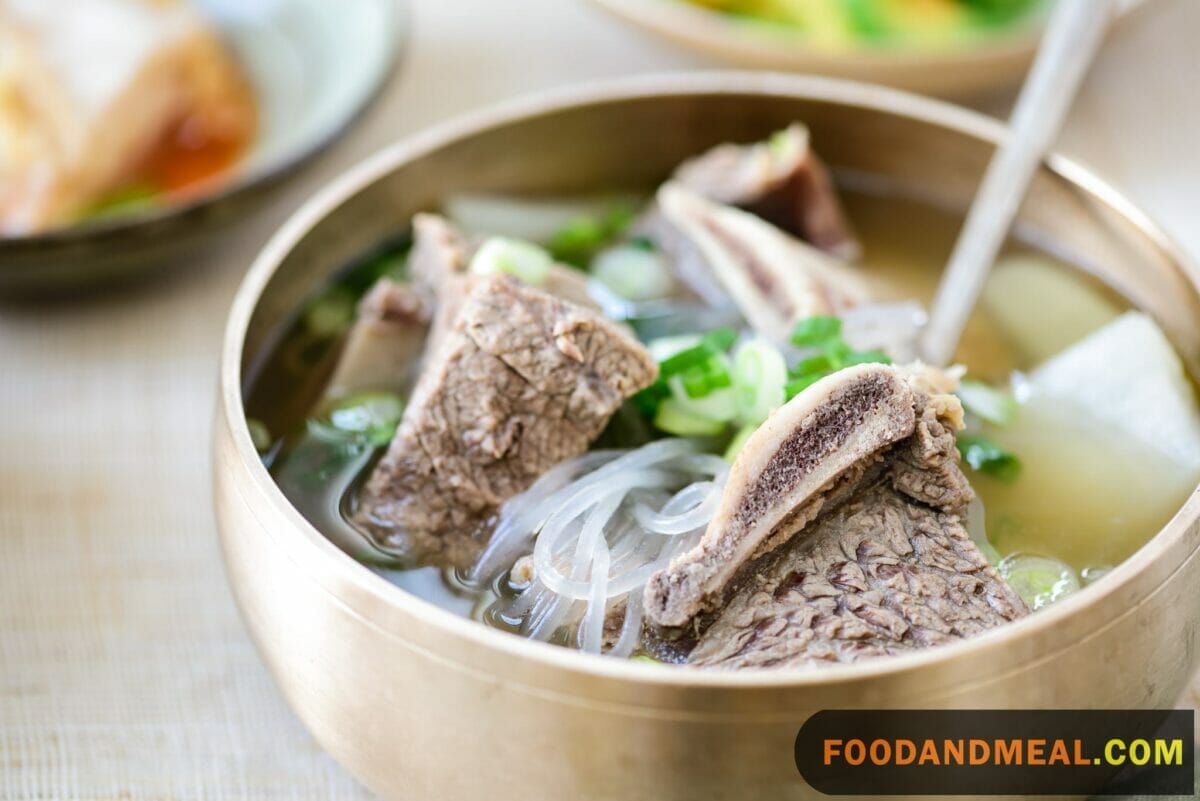
Korean Short Rib Soup Recipe
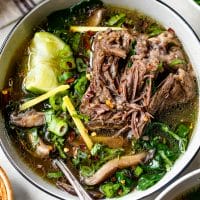
Korean Short Rib Soup
Equipment

Ingredients
- 2 pounds English-cut beef short ribs, cut into 2-inch squares
- 3 tablespoons soy sauce or gluten-free soy sauce
- 2 teaspoons toasted sesame oil
- 6 garlic cloves, 4 cloves sliced and 2 cloves minced
- 1 teaspoon freshly and finely ground black pepper
- 1/2 large Korean radish or 2 daikon radishes, peeled and cut into 1-inch slices
- 2 teaspoons salt
- 4 ounces glass noodles
- 2 scallions, cut into 1-inch pieces
- Gochugaru, for garnish (optional)
Instructions
- Rinse the ribs well with cold water to remove any dried blood or bones. Soak the ribs in cold water for 1 hour. This helps draw some blood out. Drain and discard the water.
- While soaking the meat, make the seasoning sauce. In a medium bowl, stir together the soy sauce, sesame oil, minced and sliced garlic, and pepper, and then add the radish and toss to mix well.
- Put the meat in a stockpot over high heat and cover with water. Bring to a boil and simmer vigorously for 5 minutes. Remove the meat from the pot with a slotted spoon. Discard the water and rinse the pot.
- Return the meat to the same pot and cover with 4 cups fresh water. Bring to a boil, and simmer over high heat for 30 minutes.
- Add the seasoning sauce−radish mixture and the salt, stir, and cook for an additional 10 minutes.
- Add the noodles and cook for another 4 minutes.
- Add the scallions and cook for another 1 minute.
- Serve hot, garnished with gochugaru (if desired).
Video
Notes
Nutrition
© Food And Meal
This website provides approximate nutrition information for convenience and as a courtesy only. Nutrition data is gathered primarily from the Spoonacular Database, whenever available, or otherwise other online calculators.
Korean Short Rib Soup Cooking Tips
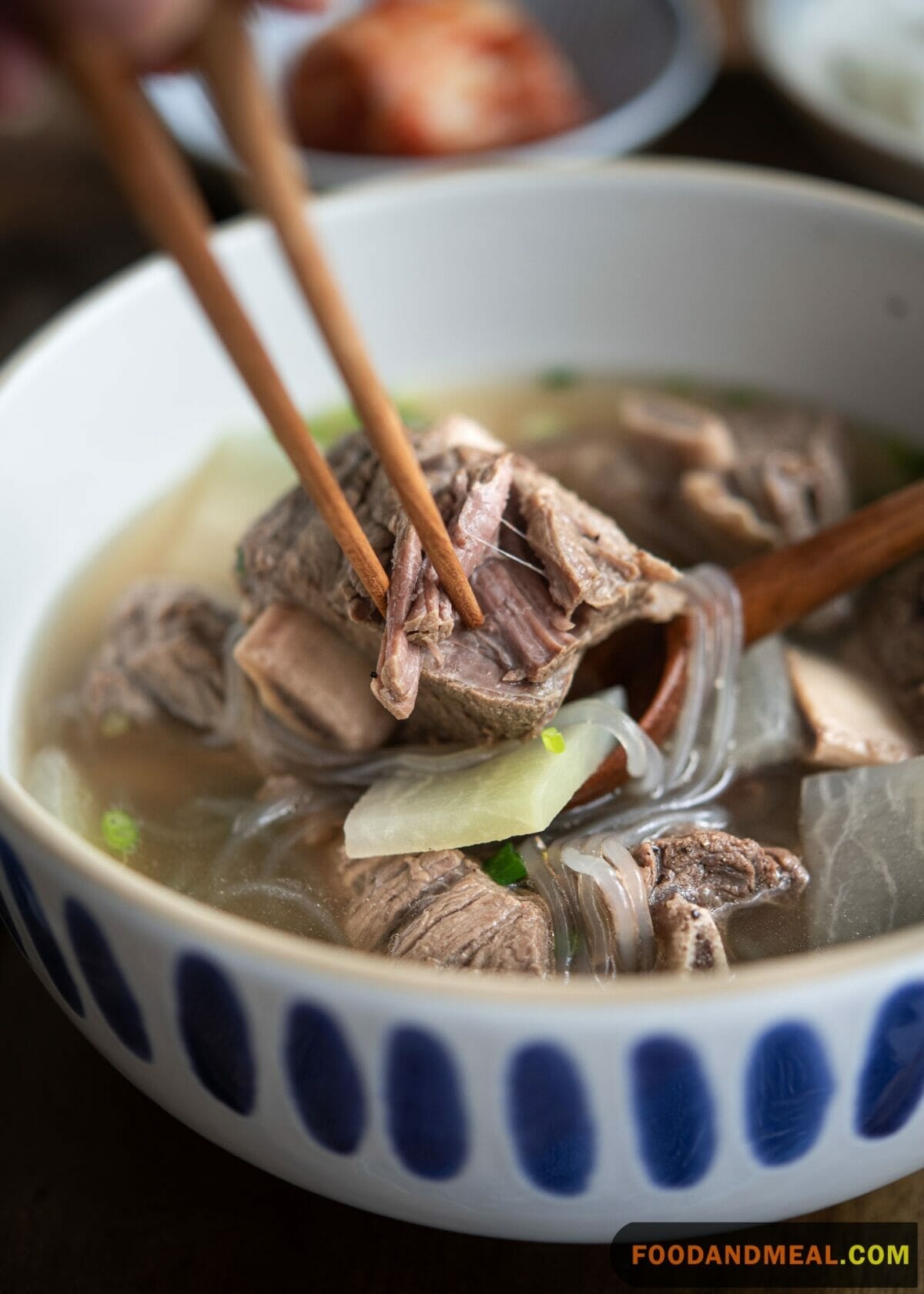
As I stand before the ingredients laid out on my counter, a feeling of calm envelopes me. Cooking Short Rib Soup is akin to painting a canvas with flavors; it’s an art that demands attention but rewards you with each simmering bubble. Here at Food And Meal, we appreciate the dance of combining elements to create something extraordinary, and I’m eager to share these gentle guiding steps so that your Short Rib Soup can be as soul-satisfying as the ones I hold dear.
- Quality of Ribs – The cornerstone of this dish lies in its star ingredient: short ribs. Make sure to select well-marbled ribs, for it’s the fat that melts away into the broth that imparts richness and a velvety mouthfeel. Embrace the patience required to find the perfect cut; it makes all the difference.
- Browning – Don’t rush the browning of the ribs. Achieving that deep, caramelized crust isn’t just about color – it introduces a complexity of flavor that becomes the backbone of your soup. Let the meat sizzle, let the edges crisp up, and breathe in the sweet savoriness filling your kitchen.
- Fresh Vegetables – There’s an almost serene joy in chopping fresh vegetables. Choose them well, wash them lovingly, and cut them with care. They’re not just nutrients; they’re brushstrokes of color that brighten the dish both visually and on the palate.
- Simmering Slowly – A bubbling cauldron of haste this is not. Low and slow is the mantra here, allowing the flavors to meld and deepen over time. This process shouldn’t be hastened; like moments of repose, they’re essential and soulful.
- Degreasing – Skim the excess fat with a tender hand, maintaining the balance and ensuring each spoonful is heartwarming without being overly heavy. It’s a small step but one that shows dedication to the craft.
- Seasoning Thoughtfully – Salt coaxes flavors forward, but remember, it’s easier to add than to take away. Season with a thoughtful touch, tasting and adjusting, working until each element sings harmoniously with the others.
- Garnishing with Greens – Lastly, garnish with a sprinkle of fresh herbs before serving. It’s a whisper of vibrancy that lifts the spirit and completes the dish aesthetically and gastronomically.
Serving Suggestions for Korean Short Rib Soup
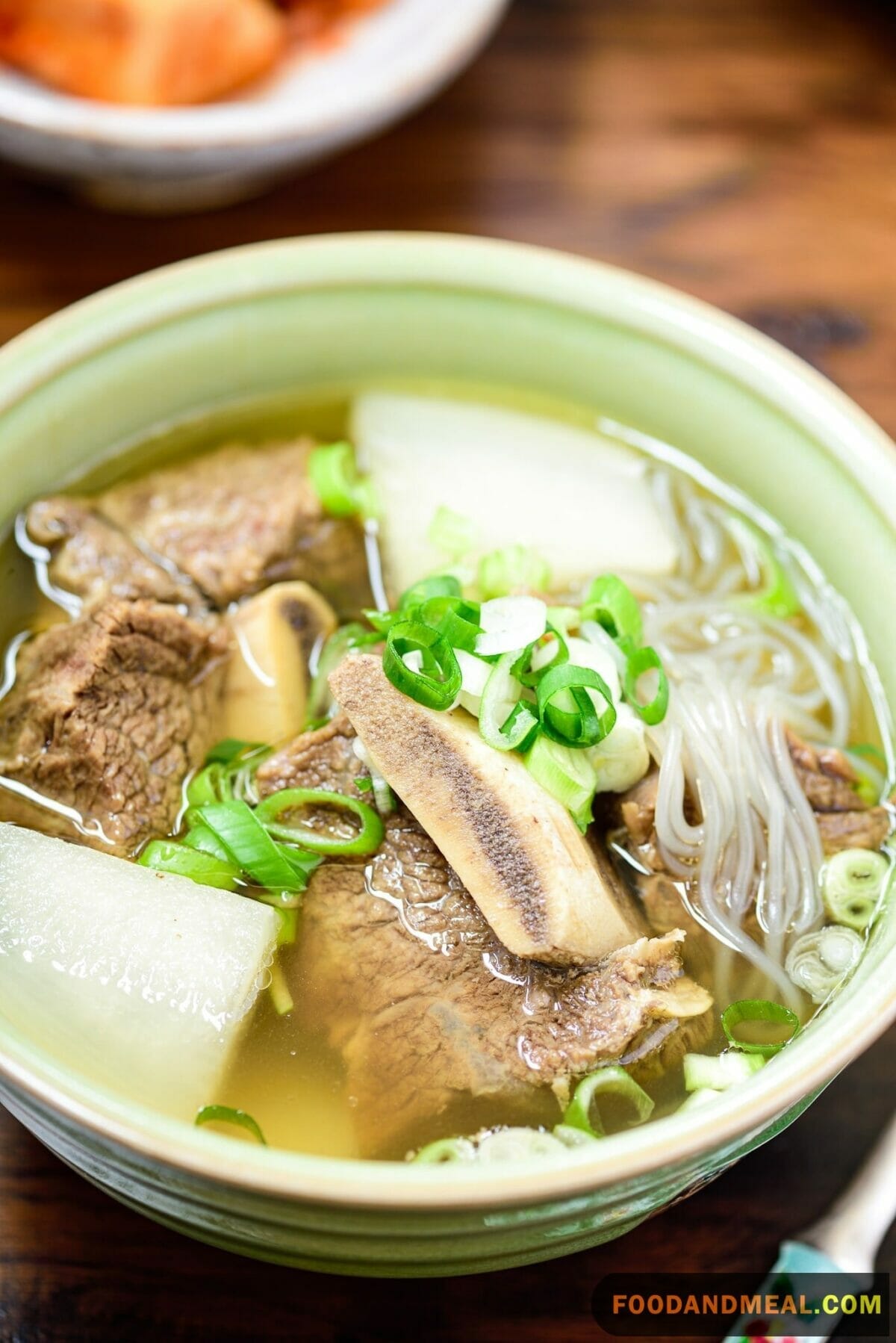
Firstly, consider the earthy notes of Short Rib Soup and pair them with the refreshing Kohlrabi Salad. The crisp textures and light dressing will balance the succulence of the short ribs beautifully, offering a palate-cleansing effect between spoonfuls of the savory broth.
For a touch of indulgence, serve the soup alongside Scallion Pancakes. Their crispy edges and soft, onion-laced layers make them a delightful contrast to the tender meat and provide a satisfying crunch that dances with the soup’s velvety texture.
To keep up with the warm and comforting theme, Veal Gremolata could be a rich and aromatic side, elegant in its simplicity, allowing the lemon zest and parsley to cut through the richness with brightness and herbaceous pops.
If you’re looking for a carbohydrate to soak up that delicious broth, consider the Vegetable Maki. The rolls provide a substantial yet light alternative, capable of absorbing flavors without competing with the main star of the meal, the Short Rib Soup.
Finally, for those with a sweet tooth, end the meal with the warming spices and sweetness of Cherry Cobbler. The soft baked fruit and golden crust make for a lovely dessert that echoes the comfort found in your soup without overwhelming the senses.
FAQs on Korean Short Rib Soup
The world of Korean Short Rib Soup is as vast as the flavors in every sip. Over the years, I’ve encountered curious minds with questions. Here are answers to some of the most frequent queries.
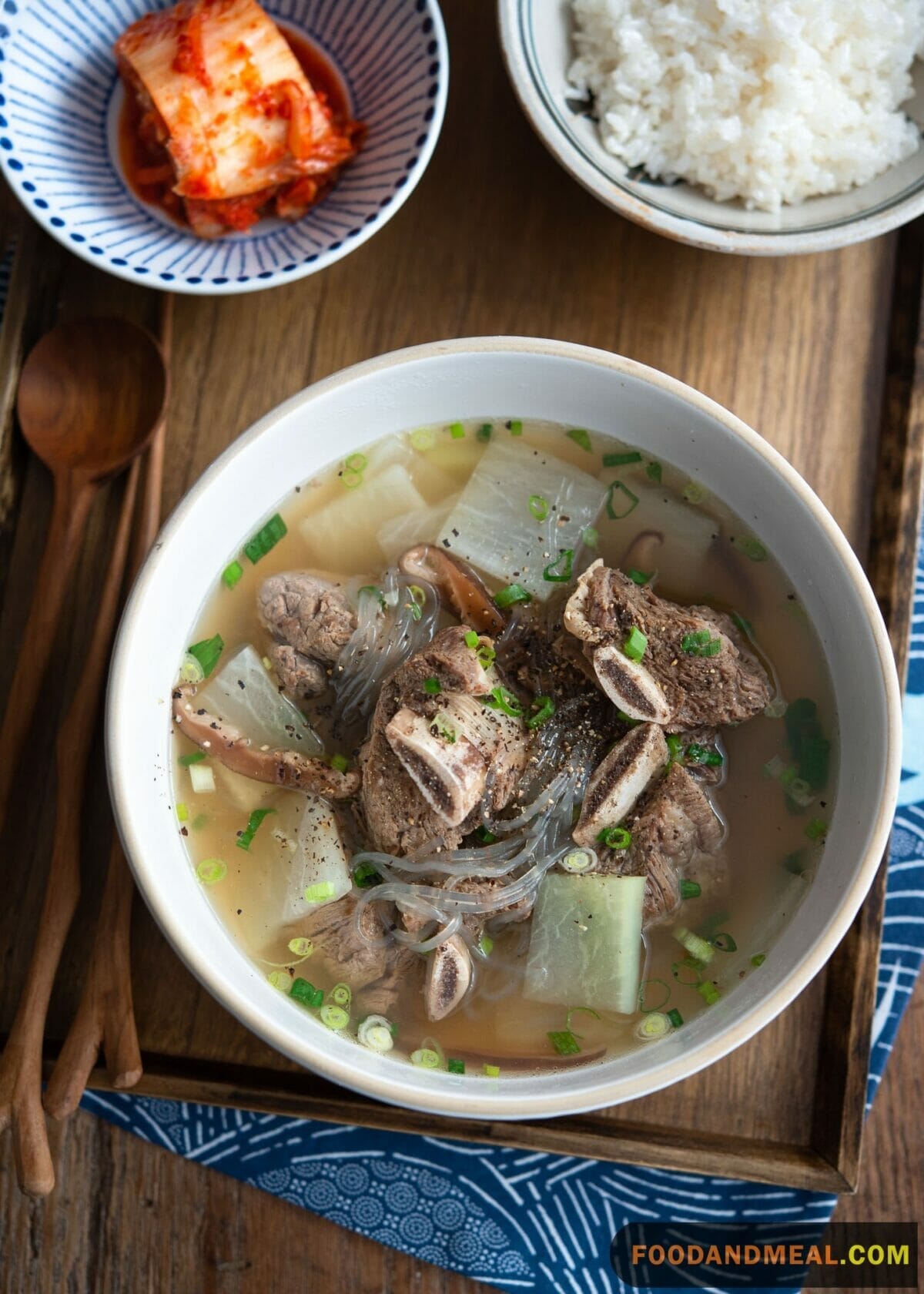
- Are short ribs good for broth? Yes, short ribs are excellent for broth. The bones and meat impart rich flavors and depth to the broth, resulting in a savory and satisfying base for soups like galbitang.
- Why boil short ribs? Boiling short ribs serves to extract the flavors from the bones and meat, creating a hearty and flavorful broth. This process also helps to tenderize the meat, contributing to the overall taste and texture of the dish.
- Is galbitang good for you? Yes, galbitang can be a nutritious choice. The dish features lean beef short ribs, providing a good source of protein, and the broth may contain essential nutrients extracted during the boiling process.
- What beef is good for soup? Generally, beef cuts with bones, like short ribs, shanks, or oxtails, are excellent choices for flavorful soups. The bones contribute to a rich broth, while the meat adds substance and taste.
- Can I use boneless ribs? While boneless ribs can be used, I’d highly recommend bone-in for that flavorful, deep broth. The marrow plays a significant role in achieving the authentic taste.
- What if I don’t have access to Korean ingredients? While traditional ingredients are recommended, you can substitute with locally available ones. For instance, instead of Korean radish, use regular white radish but adjust the cooking time.
- How long can I store the soup? Leftovers can be refrigerated for up to 3-4 days. Ensure it’s stored in an airtight container to maintain the freshness.
- Can I freeze the soup? Yes, the soup freezes well. Pour into freezer-safe containers, leaving an inch of space on top for expansion. It can be stored frozen for up to a month.
- How do I reheat the soup? For best results, thaw overnight in the refrigerator if frozen, then reheat on the stove on low heat till it comes to a gentle simmer.
Conclusion
As the last spoonful of Rich Short Rib Soup is savored, and the contentment of a meal well-eaten settles over the dinner table, it’s hard not to feel a sense of gratitude. Gratitude for the simple ingredients that came together to form something so comforting, for the laughter and stories shared over steaming bowls, and for the recipes that allow us to express love in its most universal language: food.
Here at Food And Meal, each recipe we share, each story we tell, is aimed at bringing people closer, turning meals into experiences, and ingredients into memories. The Short Rib Soup you’ve just enjoyed is no exception. It’s a reflection of our commitment to providing you with dishes that are more than just sustenance; they’re the threads that weave the tapestry of our shared culinary heritage.
As we part for now, I hope that this blog post has not only guided you through the steps of making a majestic soup but also inspired you to create moments of joy around your own table. May you always find comfort in the kitchen, unity around the dining table, and pleasure in every bite.
Hi! I'm Nazia of ‘Nazia Cooks’, a self-taught baker and cook residing in Chennai. Rooted in the rich South Indian culinary landscape, my palate has expanded to embrace global flavors. I revel in crafting fusion dishes, melding traditions to birth unique tastes.




